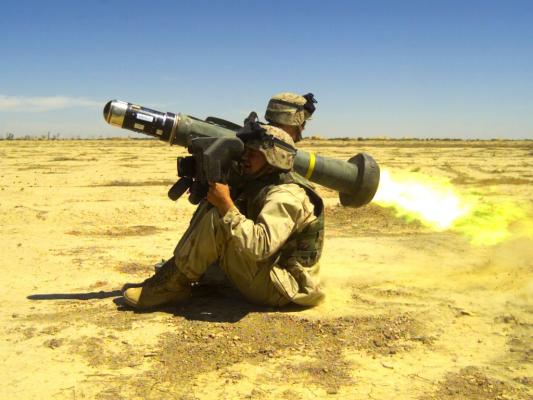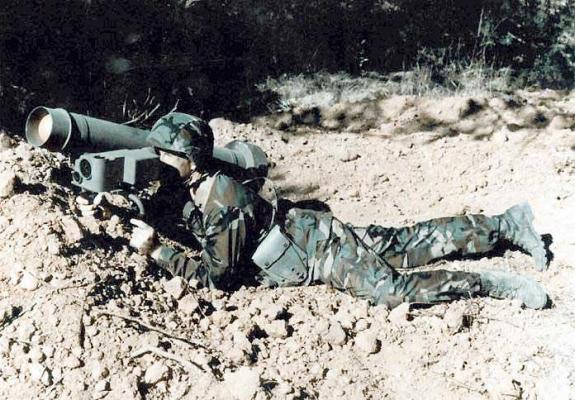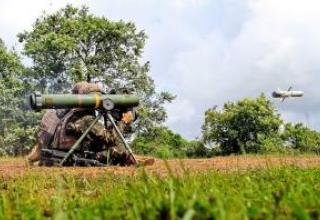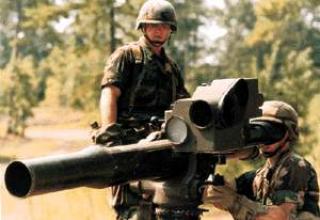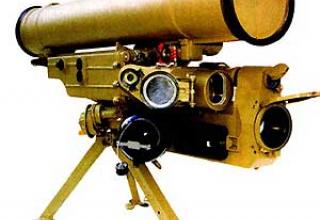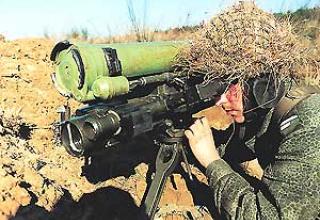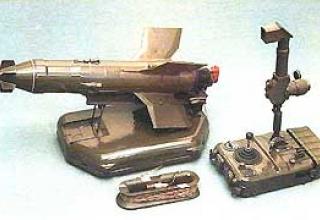The third-generation FGM-148 Javelin anti-tank missile system (ATC) has been developed since 1986 by Javelin Joint Venture (Louisville, Texas), founded by the U.S. firms Texas Instruments Missile Systems (now Raytheon Electronic Systems) and Martin Marietta Electronics & Missiles Group on behalf of the U.S. Army under the AAWS-M (Advanced Anti-Tank System Medium) program, and is intended to replace the M47 Dragon ATC.
The complex was adopted for service in 1996.
The total cost of the Javelin AAWS-M (Advanced Anti-Tank System Medium) development and production program was $5 billion. The cost of the complex when purchased for the U.S. Army and Marine Corps is about 73 thousand dollars in prices of 1992. The production program till 2005 is 9000 pieces.
During the flight tests at the stage of full-scale development, M60 tanks and Russian T-62 and T-72 tanks were used as targets.
The Javelin complex was supplied for export to the Armed Forces (AF) of the Netherlands (240 complexes), Spain (12 complexes), Taiwan (40 complexes, 360 missiles), Jordan (30 complexes, 110 missiles). Consideration is being given to the purchase of systems for the British Armed Forces and to joint production for the Norwegian Armed Forces.
Composition:
Unlike the second-generation systems that require the operator to stay in position after launch and point the missile at the target, the Javelin system implements the "shot and forget" principle, which allows the operator to go into hiding after the missile launch or change the position, which increases the survivability of the operator and the complex as a whole.
The Javelin complex is a part of it:
- A rocket placed in a transport and launch container (TLC) equipped with an infrared homing head (HID);
- aiming and launching device.
The rocket is made according to the normal aerodynamic scheme with opening wings. Matrix radiation receiver GSN rocket format 64 * 64 elements has a spectral range of 8-12 microns, is made of semiconductor compound CdHgTe (solid solution of cadmium telluride and mercury).
The sighting and launching device (FPU) has a combined all-day sight, which can be additionally used for observation of the battlefield. The day sight is equipped with fourx magnification optics. The night infrared sight also uses a larger format IR matrix receiver, which allows shooting at night and in poor visibility. The night sight provides four or nine times magnification, depending on the mode of operation. Power source - disposable lithium thermal battery BA5590 (operating time 4 hours).
FPU is equipped with a built-in system for monitoring the technical condition of the complex.
The firing process is as follows. The operator observes the battlefield with the daytime telescope sight or night sight, captures the target, combining it with the crosshairs of the telescope sight, and then switches to the missile's GOS, which has a narrower field of view. After marking the target with the cursor on the video screen and capturing the CNS target, the operator launches the missile.
The missile has two modes of target attack: the dive mode (dive angle 45°) and direct attack in the horizontal plane. The first mode is used when acting against tanks and allows to hit the target from above in the least protected area, the second - against protected objects (such as a bunker, DOT, DZOT) and helicopters. The missile is launched at an angle of 18° to the horizon by means of an embossing propulsion system, then a marching engine is launched and the altitude is set - 150m for the dive mode or 50m for direct attack of the target. The missile is controlled in flight by changing the thrust vector, which provides the maneuverability needed to hit targets from above at short ranges.
Due to the low emission of gunpowder gases at the start and "soft" launch, the Javelin rocket can fire from the premises of limited volume.
The complex is resistant to electronic countermeasures.
Characteristics:
| Range of fire, m | 50-2500 |
| Maximum flight speed, m/s | 300 |
| BC type | tandem cumulative |
| Armor-piermeable, mm | 750 |
| Weight of the complex, kg | 22.5 |
| The diameter of the rocket, mm | 126.9 |
| The length of the rocket, mm | 1081.2 |
| Mass of the rocket, kg | 11.8 |
| Length of TPK, mm | 1198 |
| Diameter of TIC, mm | 142.1 |
| TPC weight, kg | 4.1 |
| Weight of aiming and launching device, kg | 6.36 |
| Shot preparation time, s | 30 |
| Recharging time (TPC replacement), s | 20 |
| Calculation, man. | 1-2 |
Testing:
One of the first carriers of the complex is a multipurpose nuclear submarine of the project 885 "Ash", which belongs to the fourth generation of submarines. The keelmark in the series, called "Severodvinsk", took place on December 21, 1993. The boat carries 24 missiles in inclined launch shafts. The natural model of the new anti-ship missile in an export version (a variant for underwater, surface and shore-based), was first publicly demonstrated at the exhibition MAKS-97. It was also exhibited at MAKS-99.
The advertising passport for the small rocket ship of project 21632 "Tornado" (approved on 26.04.2008) indicates the possibility of placing the Yakhont complex as one of the weapon variants.
According to military analysts' forecasts, the Yakhont complex will have no analogues in the world for another 10 years. This can be proved by the interest expressed by foreign buyers. A number of countries of the Asia-Pacific region, the Middle East, which in the past bought Russian ships and boats with cruise missiles, have already become interested in the novelty of the domestic military industrial complex. PCR Yakhont also has good prospects in terms of upgrading foreign-built ships, where it can replace the Harpoon, Exocet, and Otomat anti-ship complexes.
Sources:
- Army Technology - Javelin - Anti-Armour Missile
- Video of Army's New Javelin Anti-Tank Weapon
- http://www.fas.org
- М. Растопшин "Особенности развития зарубежных ПТРК", "Техника и вооружение ",N 1, 2002.
- http://www.inetres.com/gp/military/infantry/antiarmor/Javelin.html
